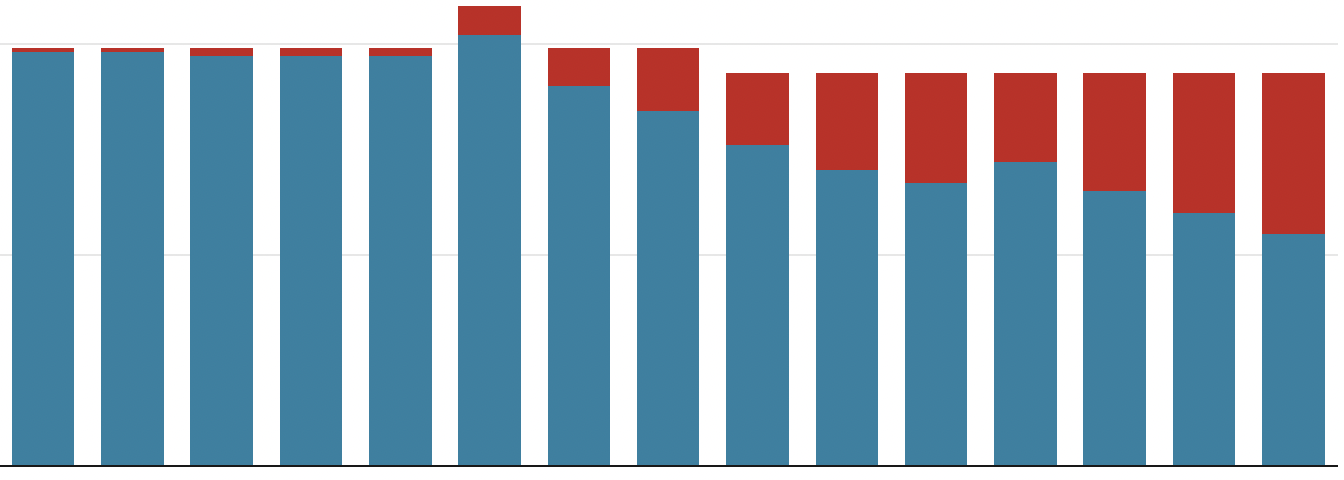There has been an uptick in the number of women elected to parliament in both chambers at the recent NSW election, which I expected before election day. Now that we know how most of the seats have fallen, we can show how much has changed in terms of gender balance.
The Legislative Council looks set to elect more women than men for the first time, although it’s likely there will still be a majority of men once you factor in the continuing members up for election in 2027.
The increase in the Legislative Assembly is less dramatic. Labor has almost reached gender parity in their lower house ranks, and the Greens MPs are all women, but the Coalition and independents are more male-dominated.
Let’s start with the Assembly:
The number of women in the Assembly has increased from 33 (35.5%) to 38 (40.9%). This assumes that the Liberal Party wins Ryde. If Labor were to pull out a win, it would result in 39 women.
Labor has elected 23 men and 22 women. If Lyndal Howison won in Ryde, it would have been 23 each. All three Greens lower house MPs are women.
On the other hand, just eleven out of 36 Coalition MPs are women - that's 30.6%.
Unlike in federal parliament, the independents are mostly male. Just two out of nine members are women.
The picture is a bit different in the upper house. At the moment the 21 leading candidates include eleven women and ten men. If the Animal Justice Party (who are running a woman) were to chase down the Shooters or Liberal Democrats, that would become a 12-9 split.
Labor has elected four men and four women. The Coalition has elected four women and two men, and the seventh Coalition member who looks set to be elected is also a woman. That's a remarkable split.
Both the Greens who won seats are women, while the sole members for One Nation, Legalise Cannabis, Liberal Democrats and Shooters, Fishers and Farmers are all men.
The Legislative Council has regularly included more women than the Assembly since it was first directly elected in 1978. Interestingly the proportion of women elected reached 40% in 1991, but when the number elected was increased from 15 to 21, the proportion of women dropped back to just 24%, and hadn't reached the 1991 proportion until now.
There are another 21 Legislative Council seats not up for election until 2027. In 2019 this group included 13 men and 8 women. The balance changed when David Shoebridge was replaced by Sue Higginson. But two members resigned to run for a new seat: Natasha Maclaren-Jones and Mark Latham.
(EDIT: After publication I confirmed that Scott Farlow, who held a seat that had expired at the 2023 election, will be replacing Maclaren-Jones.)
When you factor in the numbers from the continuing seats, the Coalition has eight women and seven men. Labor has six men and nine women, so it's the reverse of the trend in the Assembly. The Greens have four women, and Animal Justice has one woman, but the other seven crossbenchers consist of six men and one vacancy.
So that means the current chamber is 22 men, 19 women and one vacancy.




It will be 20, very confident about Ryde, I’ll eat my hat if Labor doesn’t win.
Sorry I meant 23, was reading the wrong section. There is a reason Green hasn’t called the seat. He thinks Labor still has a good chance.
Having hat for dinner tonight Daniel? https://www.abc.net.au/news/2023-04-08/sydney-seat-ryde-won-by-liberals-by-50-votes/102202348
Maybe we should send a Baggy Blue Cap to Daniel T, given he is in Queensland…
How many are gay?
Comments are closed.